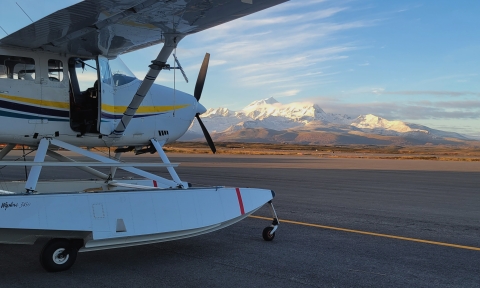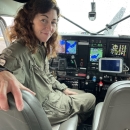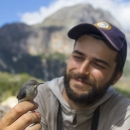States
AlaskaEcosystem
CoastalOverview
The Fall Pacific Black Brant Photo Survey is a project aimed at monitoring the population of the Pacific Black Brant population (Branta bernicla nigricans) during their fall staging period at Izembek Lagoon in Alaska. Traditionally, estimates of geese and other waterfowl at Izembek National Wildlife Refuge relied on the eyes of biologists flying in small airplanes. However, we have now adopted innovative aerial imagery and automated counting methods to improve population estimates.
In this new approach, the airplanes remain the same, but the eyes have been replaced by high-resolution cameras equipped with 200 mm lenses. These cameras capture images from high altitudes, allowing us to zoom in and clearly see the birds on the water below. Each flight generates tens of thousands of images—far too many to manually count! To tackle this challenge, software engineers have developed a computer program that automatically detects, identifies, and counts Brant, with the potential to train it for other species of waterfowl.
This advanced methodology significantly enhances the accuracy of our population estimates, reduces the costs associated with data collection, minimizes disturbance to the birds, and improves the safety of our aircrews. By employing these innovative techniques, we not only gain a better understanding of Pacific Black Brant populations but also inform sustainable management practices for hunters.
Importance of this Work
The fall Pacific Brant Photo Survey is crucial for monitoring the Pacific Brant population, particularly as thousands of geese gather every fall at Izembek National Wildlife Refuge in southwestern Alaska to "stage," resting and feeding in preparation for their migration to lower latitudes. This congregation of geese attracts hunters and birdwatchers from around the world, making the refuge an important resource for recreational activities and local economies. Pacific Brant are a key species in this maritime ecosystem, and their population dynamics can indicate broader environmental changes, helping us assess the health of their habitats and the impacts of climate change climate change
Climate change includes both global warming driven by human-induced emissions of greenhouse gases and the resulting large-scale shifts in weather patterns. Though there have been previous periods of climatic change, since the mid-20th century humans have had an unprecedented impact on Earth's climate system and caused change on a global scale.
Learn more about climate change . This project is especially important to this species of conservation concern, as it provides the best indicator of stability or change in population size.
With Izembek Lagoon supporting the entire Pacific Flyway population of Pacific Black Brant in the fall, this survey provides a unique opportunity to efficiently survey their numbers and track annual abundance and productivity. Accurate population estimates are essential for managing hunting regulations and ensuring sustainable harvest limits. Furthermore, the innovative methods developed through this project, such as automated counting algorithms, set a precedent for future wildlife monitoring efforts, enhancing our ability to conserve not just brant, but other migratory bird species as well.
Actions WE ALL can take
Giving them space: disturbance. Waterfowl like many birds, rely on a variety of habitats throughout the year to rest, feed, and raise young. It is important to avoid disturbing birds by keeping your dog on leash, watching birds from a distance, and limiting interactions that may flush birds needlessly.
Leave the Lead. Smart hunting practices help conserve birds for future generations. Remember to use steel shot for hunting (lead shot is illegal for hunting waterfowl). If you enjoy fishing, remember to properly dispose of monofilament line, lead weights, and hooks. If left in the water, these items often cause injury or death to birds, fish, and other wildlife. Lead poisoning is a serious hazard for birds. Most tackle, especially weights and jigs, are made of lead, which is a toxic metal that can be fatal when ingested by birds and other wildlife. Tragically, many of these poisoned birds are not rescued until it is too late.
Smart Hunting Practices. Stewardship of our harvested species takes all of us. Follow all hunting regulations for the area and for species you are hunting. Only shoot birds you can reliably identify, and most importantly, practice safe hunting practices Some waterfowl, like Emperor Geese, are slower to reproduce, so it is best to take juveniles or opt for other species if possible. Following the annual harvest limits set by biologists is critical to make sure hunting isn’t negatively impacting a species’ population. By setting and following sustainable harvest, we can ensure that hunting is not an additional stressor to the Pacific Brant population. Harvest limits are a controlled way to prevent overexploitation of a species and ensure hunting remains a balanced activity alongside other efforts addressing threats Pacific Brant face.
Additional information:
Weiser, E. L., P. L. Flint, D. K. Marks, B. Shults, H. M. Wilson, S. Thompson, J. B. Fischer. 2022. Optimizing surveys of fall-staging geese using aerial imagery and automated counting. Wildlife Society Bulletin; e1407. https://doi.org/10.1002/wsb.1407
Q&A about Improving Aerial Surveys of Geese in Alaska with Aerial Imagery









